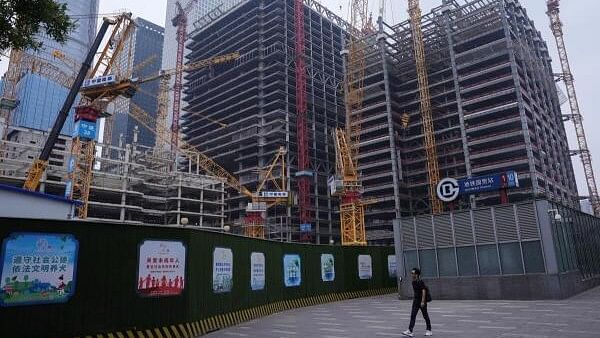
A person walks past a construction site in Beijing's Central Business District (CBD), China July 14, 2024.
Credit: Reuters Photo
China's ruling Communist Party commenced its so-called third plenum on Monday, a major meeting held roughly once every five years to map out the general direction of the country's long-term social and economic policies.
Its Central Committee convened the plenary session, or plenum, the third since its members were elected during the party's last congress in 2022, to deliberate on a key policy document on deepening reforms and advancing China's modernisation.
The closed-door meeting presided by Xi Jinping, head of the party's Central Committee, will end on Thursday with a plan to lay out China's policy direction for the next five years and beyond.
The plenum kicked off as China reported its slowest rate of economic growth in April-June since the first quarter of 2023, weighed down by a protracted property down-spiral and weak demand from cautious consumers.
What are Plenums?
The party holds a major congress twice a decade. Members of the Central Committee, the largest of the party's top decision-making bodies, are elected at each congress. The 20th Central Committee was chosen at the last congress in October 2022.
In between congresses, the Central Committee hold seven plenums attended by all of its current 205 members and 171 alternate members.
The first, second and seventh plenums typically focus on the power transition between Central Committees.
The fourth and sixth plenums generally centre on party ideology.
In recent decades, the third plenum has focused on long-term economic reforms, while the fifth plenum is associated with deliberations for the country's five-year development plans.
The current five-year plan ends in 2025.
Why are third plenums important?
This week's third plenum, described by Chinese state media as "epoch-making", is expected to deliver major initiatives to address the risks and obstacles related to China's long-term social and economic progress.
The third plenum in December 1978 under Deng Xiaoping initiated China's economic reforms, fuelling its rise from a centrally planned backwater to a global economic powerhouse.
At the third plenum in November 2013, the Central Committee vowed to let markets play a "decisive" role in allocating resources in the economy.
Since the 1990s, third plenums have been mostly held in the autumn, with exceptions in 2018 and this year.
The third plenum in February 2018 urged the party to "unite closely" around the central committee with Xi at the "core", and proposed the removal of a constitutional clause limiting presidential service to two terms.
Days later, China's largely rubber-stamp parliament voted to remove presidential term limits, allowing Xi to stay in office indefinitely.
The current Central Committee was widely expected to have held its third plenum in the autumn of 2023, but it did not. No explanation has been given.
What will this third plenum focus on?
Since lifting more than 800 million people out of poverty since the late 1970s, China now lies at a crossroads where observers fear the world's second-largest economy could settle into a long period of low growth or even Japan-like deflation.
The third plenum this week will help China better navigate complexities in global landscapes, advance its economic transformation, and enhance the people's "sense of gain", state media has cited Chinese think-tanks as saying.
At the last fifth plenum in 2020, the party said it aimed to boost per capita gross domestic product (GDP) to the level seen in moderately developed nations by 2035.
By that time, disparities in urban-rural development, in development between regions, and in living standards will be significantly reduced, it said.
The modernisation of China's military will also be "basically" achieved.
This week, the third plenum will outline efforts to promote advanced manufacturing, revise the tax system to curb debt risks, manage a vast property crisis, boost domestic consumption and revitalise the private sector, policy advisers have said.